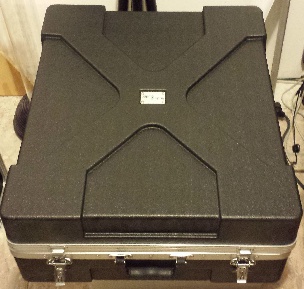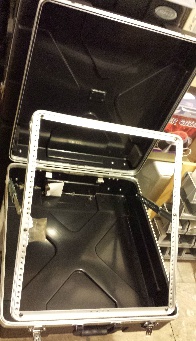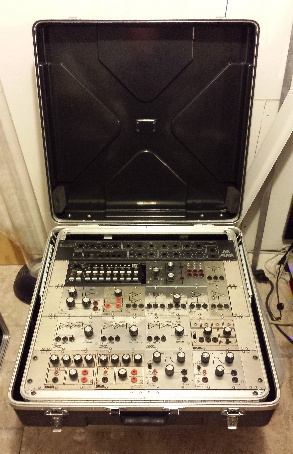|
|








Paia Synthesizer Road Case
I bought my first synthesizer from a friend when I was attending DeVry Technical Institute in Phoenix, circa 1975. I had read
about the synthesizer in some of my electronics magazines (Radio Electronics, May 73 thru Oct 73) and when he offered to sell
it to me I jumped at the opportunity. It was a really simple 2700 series 'bottom of the line' synth with a button board in place of a
keyboard (pictured above right) but it worked... sort of. Anyway, I did a little tweaking on a few of the module boards and got it
to make some sounds. It was really basic, just one VCO, an LFO, BP & LP filters, a VCA, and an ASR envelope generator.
There was a power supply module also that had a couple of bias voltage sources and a few multi-patch jacks to tie things
together. It uses 3mm audio plug patch cords for audio and pin-plug patch cords for control voltage patching.
I kind of lost interest in it because it was so limited in its capability and stored it away. I eventually lost track of the case/keyboard and it disappeared never to be seen again, the victim of a clean-up effort at some point I guess.
Anyway, years passed and I rekindled my interest in getting it back into some kind of working order. I also started checking on ebay and found that the Paia modules were showing up regularly, so started buying what I could of the 2700 and 4700 series modules. Later, I found a nice deal on a 19" rack case that looked like it would work for building up a nice synth out of the modules I had been collecting for a few years. I did some measurements of mounting holes for the modules and built a mounting rail system into the case. Upon completion of that I started mounting the modules into the case and everything fit very well, the case being just deep enough to accomodate the depth of the boards behind the mounted modules. Having mounted all of the modules into the case I still had some space, so decided to include a small Korg sequencer I have, as well as another Paia synth - the "FatMan" synth. That pretty much filled the space with 1 RU still left at the top where I will probably place an AEC power connector and maybe a few extra DC bias controls / outputs. For patch cords and such I will probably magnetically attach a zipper bag inside the top of the case.
Following all this I had to set this project aside for a while in favor of a few other projects I was working on (and my regular 'day job'). About a year passed and a change of address was under way. Now it's been a few more years and I'm retired and getting back to all of the projects I have stored away, including this one. Below are a few photos of the synth I've built up with the modules. As you can see, the FatMan is not yet assembled. It's currently just the faceplate installed as a placeholder. I still need to cobble up some kind of power buss into the case behind the modules and then begin testing, repairing, modding and calibrating the modules so they can actually be used to generate some real music or (preferably) weird fantastical sound effects.
So this is a project kind of in the middle of its construction, which will be detailed on this page later once I get back to it.
I kind of lost interest in it because it was so limited in its capability and stored it away. I eventually lost track of the case/keyboard and it disappeared never to be seen again, the victim of a clean-up effort at some point I guess.
Anyway, years passed and I rekindled my interest in getting it back into some kind of working order. I also started checking on ebay and found that the Paia modules were showing up regularly, so started buying what I could of the 2700 and 4700 series modules. Later, I found a nice deal on a 19" rack case that looked like it would work for building up a nice synth out of the modules I had been collecting for a few years. I did some measurements of mounting holes for the modules and built a mounting rail system into the case. Upon completion of that I started mounting the modules into the case and everything fit very well, the case being just deep enough to accomodate the depth of the boards behind the mounted modules. Having mounted all of the modules into the case I still had some space, so decided to include a small Korg sequencer I have, as well as another Paia synth - the "FatMan" synth. That pretty much filled the space with 1 RU still left at the top where I will probably place an AEC power connector and maybe a few extra DC bias controls / outputs. For patch cords and such I will probably magnetically attach a zipper bag inside the top of the case.
Following all this I had to set this project aside for a while in favor of a few other projects I was working on (and my regular 'day job'). About a year passed and a change of address was under way. Now it's been a few more years and I'm retired and getting back to all of the projects I have stored away, including this one. Below are a few photos of the synth I've built up with the modules. As you can see, the FatMan is not yet assembled. It's currently just the faceplate installed as a placeholder. I still need to cobble up some kind of power buss into the case behind the modules and then begin testing, repairing, modding and calibrating the modules so they can actually be used to generate some real music or (preferably) weird fantastical sound effects.
So this is a project kind of in the middle of its construction, which will be detailed on this page later once I get back to it.
As you can see, the frame tilts up so the synth is
at a usable angle and can be easily patched while
sitting down if desired. The cover can also be
removed if desired. There are a good number more
modules now than what I started out with in the old
original 2700. The closed case can easily be
carried and set up on a table but does require an
amplifier. It also stores away nicely and safely with
room to leave the patching in if needed.
Below is a photo of the empty case - you can see the tilt-up mechanism which locks in place at various tilt angles.
Below is a photo of the empty case - you can see the tilt-up mechanism which locks in place at various tilt angles.
A project to make the old system portable











